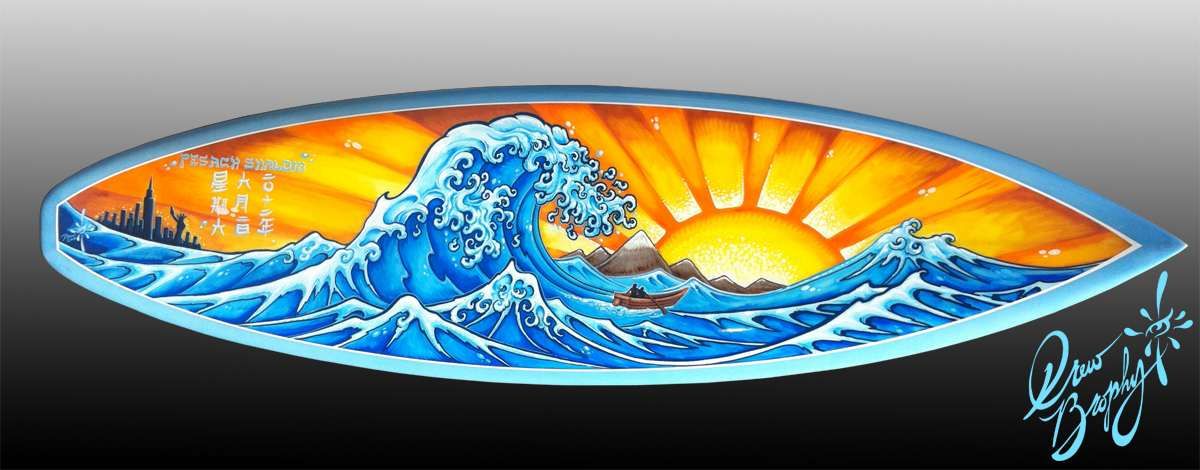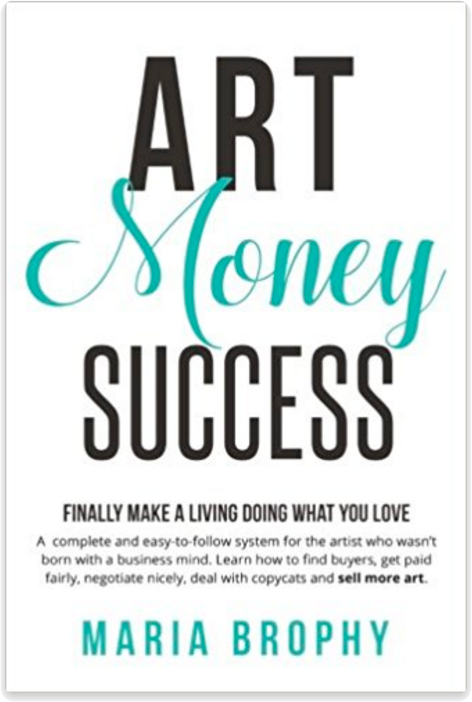The more your name is seen on your art, the more you will be remembered as an artist, the more the phone will ring, the more people will visit your website.
Two questions I get from artists on a regular basis:
“Should I sign my name to my artwork?”
And,
“My art is being printed on merchandise. Should I require my client to make my signature legible?”
If you want to be known for your artwork, and you want to gain collectors and clients, the answer is:
YES and YES!
Some artists do not sign their work. And they are making a huge mistake! Without a signature, your new fans can’t find you, and there is no way to verify who created the art.
It’s so frustrating to me when I fall in love with a piece of art, and I want to look up the artist, and I can’t find their name on it.
Plan beyond today and next week. Plan for twenty years from now. Do you want your art to be remembered? Do you want it to be recognizable? Do you want your fans to be able to know if a piece of art is authentically yours?
Signing his name helped Drew Brophy become the best known artist in his niche of surf. Here’s how:
After Drew has put the final touch on a piece of art, he signs it. His signature indicates that the painting is finished. His signature announces to the world that it is an original, Drew Brophy art piece. This is important, because he has many copycats out there. His signature authenticates the art as his own.
Over twenty years ago Drew was painting surfboards for a living. He painted thousands of surfboards that were shipped all over the world. He signed his name to every single one. He was the first production surfboard artist to ever sign his name!
When companies started commissioning Drew to create art for t-shirts, posters and beach gear, he insisted that his name and signature be clearly printed on every item.
This one little detail contributed to his lifetime success as an artist. Over time, in the surf world, he became the best known artist in that niche. People knew his name, because, well, it was on everything!
Are there ever exceptions to this rule? Yes, below are a few reasons that it would NOT make sense to put your name on your artwork:
- If you are a fine abstract artist and a signature would not work on the front of the painting – then sign the back. But add your signature or logo or some sort of copyright notice to the digital images (in a subtle way) when posting online, so that people who share your image will also share who the artist is.
- If you are an illustrator who works anonymously behind the scenes, and you sell all copyrights to your client. (You no longer have ownership or rights to the artwork.)
- If you are creating art for a graphic business logo (the client would own all copyrights to the logo)
- If you do not want to be known for your artwork. (Some artists choose this business model)
- If you are creating art different from the style you are known for, and you do not want your name to be associated with the artwork. (Example: I know a fine artist who painted a line of work under another name to sell in a market different than what he’s known for. This was strictly for financial gain, not to grow his own following.)
Here are a few tips to get the most out of your signature:
- Sign every piece of work with your name when it’s finished (if you can’t sign the front for aesthetic reasons, sign the back)
- Have a consistent signature. Sign it the same way every time. This little detail is important.
- Write the date on your art – some artists date it on the front, some write it on the back. It’s your choice, and the best way depends on the type of art you create. Just make sure it has a date on it! Years from now you will thank me for this.
- When providing digital copies of your artwork for online use (Facebook, Blog Posts, etc.), add either a copyright notice on the front of it (i.e. Artwork © Drew Brophy) and/or add your digital logo or signature, if your signature is not clearly legible. This way, when people share your art online, your name is clearly on it. (See example photo in the blog post – Drew’s signature and logo is on the image so when people “borrow” the image, his name is there.)
- If you license your art, or create for commercial use, consider creating a logo/signature that can be consistently used as part of your branding (like Drew’s signature/logo in the painting above.)
For more on this topic, read the article by ArtBusiness.com titled SIGN YOUR ART SO PEOPLE CAN READ IT.
Do you sign your artwork? And have you always signed it? If you don’t sign it, why not? Please share in the comments below!
Thanks for reading,
Maria xxoo











46 Responses
We used to put the date on our art work but we heard several comments from marketers and artists not to. Do you think it affects the marketing to date it? Or does it enhance it?
George, thanks for the question! I can see why some artists would hold back on putting the date, if they are concerned that the art will sit for a few years before selling. The reason I think you should put a date on it is so you can keep track of your paintings – this comes in handy in the future for many reasons. Also, I believe in transparency when selling art. I would never want someone to buy a piece not knowing everything about it; you wouldn’t want to misrepresent when a painting was completed, just to make a sale. Most buyers, if they love it enough to buy it, they won’t care when it was created.
I always sign my name if the artwork is not created for another businesses identification. BUT…I have not always signed it the same way. As a married woman, I have struggled with what name(s) to sign. Recently, I realized that including both names sets me apart and makes me easier to find in searches, so I plan on using both from this point forward but still find a consistent signature I like elusive.
Lisa, thanks for the comment and for sharing your practice! I have a friend who has the same issue as you – she finally settled on her maiden name. I think in your case, just making a decision will be good – it doesn’t matter what you decide – pick one, and stick with it!
Yep yep. I’ve always signed my work and what goes on line. I know my art floats around all over the net and around the world. It’s a numbers game and while still hard to get work at times, I couldn’t imagine how less I’d be known if I hadn’t always signed my work.
Dennis, nice to hear from you! It’s good your art is being “shared” online – means people love it. That’s a great thing!
Hello, glad to see you’re back, and sorry for your loss, it sucks when someone close to you dies…it means there’s one less person in the world who loves you. I know that feeling. First, I feel I should tell you that the blue type on your email can hardly be seen…second, I have a questions about putting my website on my products…one person didn’t like it but others don’t seem to notice. Your opinion? Thanks!
Alex, thanks for the comment and thanks for reading my Newsletters! Sorry about the blue ink – I’m a bit technically challenged and so my newsletters sadly reflect that! But I will fix the font, just for you, before I send the next one! 🙂 As for putting your web address on your products – it depends on the product. If you’re putting it on the front of a t-shirt, for example, you probably shouldn’t! (Place it in the neck label instead). But, if you’re printing it on the back of a greeting card, that’s ok. I suppose a good rule of thumb is this: if it takes away from the aesthetics of the product, then don’t do it.
I liked this one Maria, I think the rip current to this article is ‘two worlds colliding.’ The world of creativity and the world of marketing, ironically these two things often go together and in actual fact need each other to survive. This is where good agents such as yourself come in. I write books, I publish them myself and I can tell you that although I may have some ideas about marketing I would spend more time trying to market a book then I did writing it. A support network is the key, it’s also important to look at what some successful companies do, how many people would drink coke or Pepsi if the logo’s weren’t rammed down our throats. You have got to get your name out there if you want to do any level business. If you feel cheap by promoting yourself then employ someone to do it for you whilst you concentrate on your art.
Thanks for sharing your observations, Jay! I think promoting yourself is hard for most of us: we don’t like to brag. But, at the same time, it’s a necessary evil!
Maria-
I can’t tell you how happy I am that I found your blog. Your writing style is clear, concise, fast paced, and getting sharper every day. The information and insights you provide are invaluable for any kind of artist. I learned a while ago that I have no desire to be a starving artist, so I knew I had better start educating myself on the business side of things. I think the healthiest change for my bitter attitude came when I began to view business as its own art form, and an essential component of my repertoire. I have you and Drew, and many others, to thank for shortening the learning curve on something that can seem so overwhelming and impossible. Thank You. And be sure to tell Drew he’s the mutt’s nuts, cat’s ass, and bee’s knees 😉
Carson, thanks for the kind words! I’m glad you found me, and that my writings have been helpful. 🙂
I live in Victoria, Australia and I cannot seem to find anyone that can make a stencil of my signature for my artwork. Can anyone help?
Thanks
Trish
My question is. Can i SIgn my artwork through a different name consistently and be known for that name? kind of what Music artists and Dj’s do they go under a stage name. Am I able to do that? or does it have to be my birth name? I know this great painter and he goes under the name of Craola. please let me know your thoughts!
Brian, yes, you can sign any name you want to your artwork.
Awesome! thank you for the quick reply! I was beginning to think I had made a mistake. thank you!
i have recently created a painting that everyone who has seen it loves. I signed it simply Kate S simply because quite frankly I don’t want to use my married name; its Dutch, no one says it correctly, and besides its my husbands name and I’m not Dutch (not that there’s anything wrong with being Dutch). I’m encouraged to keep going with art and sell it and I want to be known with my own family name … my grandmother’s maiden name actually and it starts with an S too. Am I going to run into problems with this? Do I need To legally change my name or anything like that so that I can … I’m not even sure of the right question to ask here.. I guess I need to have a sense of authenticity in using a name other than my married or single surname. My reason for this has to do with the sense of value my grandmother bestowed upon me just for being me and her actually seeing me as of great value just as me. It’s a rare gift I feel, and important to me. Any thoughts on this?
I do sign my art name Maria but had conflicting advise on singing dates on prints. Maybe you have advice in that area.
Thanks for this post. I was wondering if I was making a mistake, by signing my name on the front of my paintings. I will now continue to do so,and feel confident about it.
<满金星小叶紫檀
My art attribution strategies supplements Maria’s excellent(!) tips on signing your artwork. Foremost, I want to highlight how “Orphan Works” can hurt your art business, while registering your copyrights can really help it.
Maria wrote, “…[Drew’s] signature indicates that the painting is finished. His signature announces to the world that it is an original, Drew Brophy art piece …His signature authenticates the art as his own.”
Though signing/dating your art is critically important, the way to prove the authorship and originality of your artwork is to timely register it with the US Copyright Office! When filling out your copyright registration application, you’ll have to “certify” your application with your e-signature, acknowledging that all the information provided is CORRECT to the best of your knowledge. If you materially lie (claiming another person’s artwork as yours, for example), you’re subject to a $2,500 CRIMINAL fine per 17 USC 506(e). Your registration will probably also be cancelled if you’re found guilty. See: https://www.law.cornell.edu/uscode/text/17/506.
In addition, if your artwork is registered within five-years of publication, it is deemed to be prima facie proof that you have a VALID copyright and ownership to your art. To invalidate your registered copyright, the infringer will have to locate evidence that shows you lied on your application, and that can be an impossible burden to prove if you’re the genuine author of the work.
Placing a photograph of your artwork in a self-address stamped envelope and mailing it back to yourself will NOT prove your authorship or its originality–it’s an old myth that never stops recycling itself on-line. This “poor man’s copyright” procedure only proves that the US Post Office can mail a letter back to you. By officially registering your artwork with the US Copyright Office, you have LEGAL PRESUMPTION that you are the creator (owner) of the artwork.
Maria wrote, “Some artists do not sign their work. And they are making a huge mistake!”
Indeed! By not affixing your copyright notification, name, and contact information (web or social media URL) to your artwork, you’re also making it very EASY for third parties to claim that your art is orphan (“We can’t find the artist!”), allowing them to reproduce your work without your blessing! Though the United States has yet to adopt any “Orphan Works” legislation, we may see the US Copyright laws updated in the next few years or so to include an orphan works provision.
Here’s a quick hypothetical summary of what could happen if “Orphan Works” becomes US law:
A third-party finds your artwork on social media, in a gallery, estate sale, flea market, etc., loves it, and eagerly wants to license it for a derivative use to make note cards, posters, calendars, Target pillow covers, magazine digital covers, display as background art for Hollywood films, sitcoms, plays, etc. Unfortunately, your name and/or contact information are not included anywhere on the artwork (either you chose not to include it or it was removed, either by accident or willfully). Under Orphan Works, before a party can begin to use your artwork without your permission, it must perform a “diligent” search to locate you, the orphaned author.
Third parties will likely have to visit a number of designated sites to search for the missing author. The search will likely include visiting art agencies, professional art groups, on-line databases (Google image search, Tin-Eye, etc.), and other places INCLUDING the US Copyright Office’s on-line database (another good reason to register your copyrights!). The third party will have to record the results of its diligent search before making any claims that it was unable to locate the missing artist. Complying with the orphan works protocol, these third parties will be able to reproduce the artwork without the artist’s permission. Importantly, they will NOT be liable for any copyright infringement claims brought by orphaned artists who later come forth claiming their rightful ownership (artist would likely be eligible to receive a limited licensing fee).
Now is the time for US and internationally-based artists to get on-board and mark all their artworks with a detail attribution before Orphan Works becomes US law. Watermarking and including metadata in your posted digital art files will also help mitigate your works from being orphaned and used without your permission.
As best you can, always include your name, contact information, logo/signature (watermark), metadata, and copyright attribution on your web & social media sites. When a potential new client/licensee stumbles upon your art, make it super easy for them to find you!
Thank you for such an encouraging post Maria, but my problem came about when a copyist managed to copy my signature too :((
I’ve changed it since, and I do a different signature for signing stuff in “normal life” (cheques/contracts etc). I agree with all you say, but it seems whether it is a plain easy to read signing, or a logo style sig, it could still be copied by anyone intent on real fraudulent use. I guess whatever we do to protect our art is good though, yay.
Maria ,
I have always signed my work since day one 42 years ago .
It definetly brings recognition to your work and a sense of fame but not necessarily income . You know well enough of anyone that’s a another topic , but I do believe through the years I have gotten plenty of new clients simply by word of mouth and signing your name . Can’t tell you how many times people have said to me ” oh your the guy in person I have seen your name on tons of stuff ” It works !!
Thank you for your very informative article. I, too, sign all my work. Because I have had more than 1 name change, I finally took the maiden last name of my Great Grandmother, which is “Warfield”. That will never change and it is my identity. Again, thank you for the affirmative information.
Thanks for the reminder Maria! I found it great to build my brand using my middle name as a last name.
Sometimes I do digital work and I know I get “mad” at myself when I notice I put something online and I forget to add my digital signature. Esp in a social media post, is it worth taking it down after people have already commented and liked it, to put in up with my signature. I always debate this when this happens.
Phephe, I question that myself – sometimes I post something online for Drew and it doesn’t have his name or signature on it. Then I realize it and wonder the same thing – keep it or take it down?! Usually I keep up there. I’m a risk taker like that!
Great post, Maria, and timely for me: I recently changed my business name from Artopia Creative to Alex Sanso Creative for that very reason–I’m starting to do more original works these days and feel that my own name needs to build recognition. I’ve questioned the decision off and on, because my previous business name had its own recognition factor after 7 years in business, but I think for the long haul, I’ve done the right thing. Thanks for that confirmation!
Thanks for this article. It came at great timing. I recently posted this question to an online art class I was taking, and the teacher said only amateurs sign their name. That didn’t feel right at all, then within the hour I saw this post. It was so nice to read what you wrote.
I love all your advice!! I need to work on incorporating my signature on my art more. Thanks for the reminder that it’s important. 🙂
Early on I developed a distinctive style, that was legible, for signing my watercolors. I decided to only date them on the back. Some viewers equate recent to “better” as if art might be like muffins where freshness is everything.
I’ve always signed my artwork but having a lil trouble finding my niche but really do love receiving your emails have learned a lot and hope to learn a lot more , especially in the copyright dept I desgn alot of logos and having troubles with cost and laws if you can give me any more insight be much appreciated
Kevin,
I’m happy to help, but your question is very vague. Leave a specific question here and I”ll do my best to answer!
Dear Maria Brophy,
Always an excellent post. I really like what you write. What about signing your name to create limited edition thereby increasing the price of your Giclee’s?
Dear Maria Brophy,
What about signing your name to create limited edition thereby increasing the price of your Giclee’s?
Good advice. I never thought to date any or my artwork, and re-discovering a cache of paintings and collages I did in the 1990s, I wish I would have. Love your posts- I learn so much in every one.
Maria, this is so helpful. When you think you know about something there is still a lot to learn. Recently I’ve stop signing a date on my painting and they are alred framed. However I would sign them to the back. As some gallaries don’t want old work. Also I started putting a watermark on my work when putting on social media to protect persons from copying.
Great article and amazing comments from you Maria and your informed readers! I have a question… I use my full three names (maiden as middle) but not in my signature or online as it is long. I use my name and last online and a three letter initial signature on my works. This is making me wonder if I need to at least sign my first and last on my works so that a viewer could read my name, or if signing the back in addition to the front with my full name would be better and keeping the logo like initial signature on the front? I have been branding this initial signature for about three years. Thanks for any advice!
Thanks for the reassurance!
I always sign my work with my last name, date and copyright logo.
I started off not only signing my name, but also including the date and the title of the painting! Eventually I thought, why am I putting the title on? No one else does! So I stopped including the title. Soon after, I dropped the date too. I know there are different schools of thought about having the date on it, but I think I’ll continue on with just my name. I have all the dates in my “painting info” file on my computer — in case anyone’s interested.
I started signing my work by an “artist signature name” instead of my birth name although it sounds the same which is what I like about it. My first name is Maria and when I went to pick up a take out order from a Japanese Restaurant, I saw they spelled my name Meriya…I loved it! So I got some opinions from my friends and we agreed “Meriya” would be my artist signature. My company name is now “by Meriya” since I do several types of art. I am still working on a website.
Great article, thanks Maria! So far I have been worried about posting works on Instagram with my usual, ‘official’ signature in case it would be lifted and used for fraud. Would you recommend having a signature for your art that is distinct from the one you use for documents, etc, in everyday life?
I sign my oil and acrylic paintings with “P Vener” because it detracts from the work to use more letters. However, I do often sign my full name on the back or side (I use gallery/museum wrapped canvases).
However, I also do smaller works on paper and decided to use some of these for Print on Demand greeting cards. I signed up with a PoD company that does only greeting cards and which juries in each and every card design. They told me to get rid of the signature. I do, however, make sure to have my name and copyright mark for the cards on the back.
I have since also started designing for another PoD with a lot of products. I still don’t add my signature. But should I do so? Should my mugs, (for example) have a signature or my name on them? Should I create a small mark or logo instead?
My other art form is beadweaving and the copyright rules for that are more complex. Especially if the work is functional. 😏
Hi Maria,
Thanks again for the insights and great direction. I continue to listen to your book and use the methods. Early on I always signed my work and dated it too. You also got me logging everything. Because my niche is tile art for practical backsplash and hanging art I have hundreds and I imagine thousands soon. I created an initial logo so it does not impede the art and it works even on a 2×2 magnet. Thanks again for sharing your strategies. Sending light, love and continuous healing your way. Dalmane Art Shepherd- DJO
Я бы с такими в кроватке поболел .
Matchless topic, it is pleasant to me))))